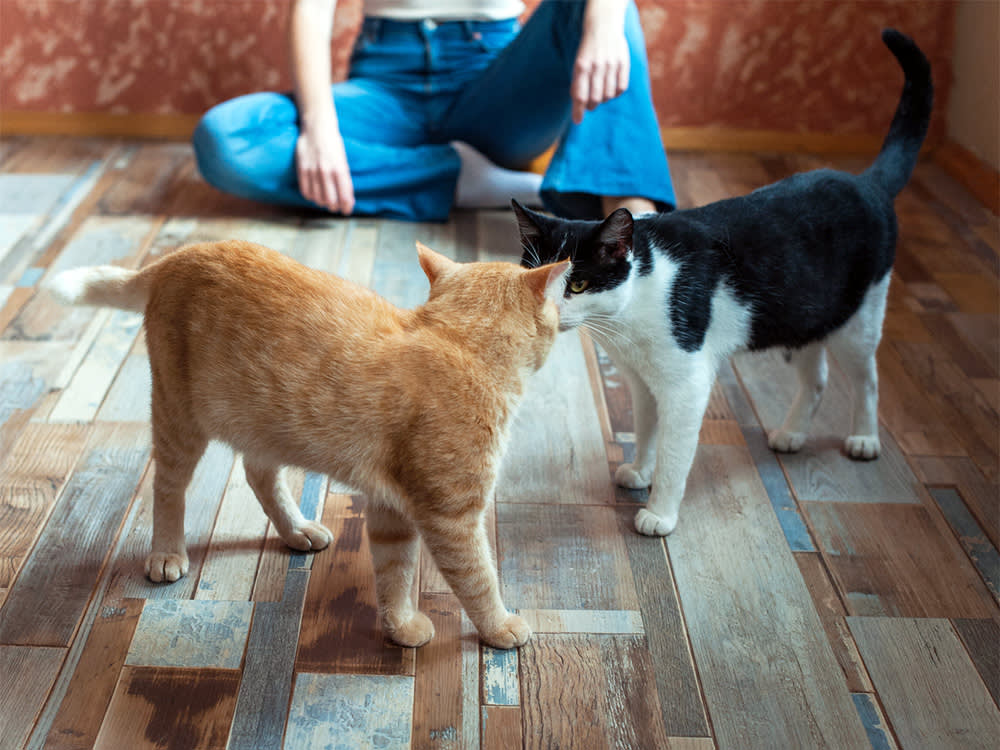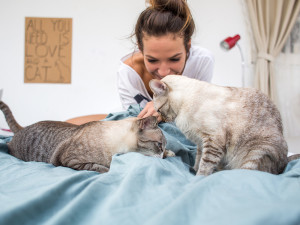How to Introduce Cats

Share Article
In This Article:
Cat Introduction Timeline Introducing Cats: Step by Step Guide Introducing Cats Without Separation How Long Does It Take for Cats to Get Along
If you’re a cat lover, just one cat is rarely ever enough. But introducing cats can be a bit of a minefield, especially when you don’t know how either pet will react. Cats have a tendency to be highly territorial toward other felinesopens in new tab, so you have to make both animals’ safety a priority and ensure that both cats are properly socializedopens in new tab before they meet.
Overwhelmed yet? While introducing two cats may seem like a challenge, it doesn’t have to be stressful. Just take things slowly, one step at a time, as we’ve outlined below. And if you’re unsure about your ability to learn how to introduce cats to each other, consider enlisting the help of a professional cat behaviorist, like Kristiina Wilsonopens in new tab, who offers some tips on how to help your cats, if not like, at least tolerate one another.
Cat introduction timeline
Introducing two cats is not something you can do in a couple hours. Sometimes, it can take weeks — or even months — before the cats feel comfortable around one another, and some cats may never enjoy each other’s company.

For the best chances of turning your cats into at least roommates who tolerate each other, take your time and learn how to introduce adult cats, moving at the animals’ pace. If either cat shows any signs of aggression or stress, such as a tucked tail or flattened ears, take a break and move back a step in the process.
If you can, try to introduce your new cat’s smell into the house before you bring them home, preferably at least a week before. Then, you can follow the general timeline below, but be ready to adjust based on how the cats react to each other:
The day before bringing a new cat home, create a designated space for the cat—ideally, a room with a door you can close.
Two days in, swap scents by switching the cats’ bedding, allowing them to smell one another.
Five days in, work on building positive associations by rewarding each cat with a favorite treat when they react calmly to the other cat’s scent.
Within a week, if all goes well, allow the cats to see each other through a barrier like a baby gate.
Ten days in, if the cats show no signs of aggression, try a supervised, face-to-face meeting.
Wilson recommends using cat pheromones as well — and having the scent going in the room before you bring a new cat home.
Introducing cats: step-by-step guide
When you’re introducing two cats, the process is far from simple. Make sure to take things slowly, step by step, and pay attention to both cats’ reactions and body language to see if you need to retreat back to a previous step.
“If you see the cat is anxious, upset, or aggressive, stop the session and restart it later after everyone has calmed down,” Wilson emphasizes.
Keep the cats separate.
“Take time in the beginning to set yourself up for success,” Wilson says. “Have a room set up with a door that shuts for the new cat, and keep them there for a day or two or a week, depending on how quickly they adjust.”
Make sure to keep the door closed so the resident cat can’t enter the room and be careful when going in and out yourself. It’s also a good idea to add a pet or baby gate at the door to prevent any unexpected encounters between the two cats before they’re ready to be pals.
Exchange scents.
Once the new cat is used to their space, allow each cat to sniff your hands and clothing after you interact with the other. This helps them get accustomed to one another’s smells. You can also swap their bedding so each cat can get familiar with the other’s scent and even sprinkle a few treats on the bedding to help create positive associations.
Let the cats explore each other’s spaces.
Continue to keep the cats separated, but allow them to explore each other’s spaces. Keep a close eye on each cat for any signs of discomfort or unhappy vocalizations, like growling or hissing.
Encourage playtime near the door (and maybe a peek).
If neither cat seems upset by the unseen presence of the other, encourage your resident cat to play near the door—without opening it yet. Use string toys to get both cats’ attention, gradually bringing them closer, with the closed door separating them. If all goes well, consider opening the door so each cat can get a glimpse of the other.
Allow the cats to meet face to face.
Finally, open the door (with the gate still in place) to allow the cats to see one another. Look for positive signs, like relaxed body language, gentle eye contact, and elevated tails. If there is no hissing or signs of fearopens in new tab or aggressionopens in new tab, remove the gate and allow the cats to interact. Always supervise these interactions and continue to separate the cats when you’re not home until they’re comfortable being alone together.
Introducing cats without separation
While you can introduce cats without separating them first, most experts don’t recommend this strategy. Some cats may do just fine with a sudden intro, while others may become stressed, territorial, and even violent.
Before attempting a quick introduction, consider how well you know both cats’ temperaments and how comfortable you are with handling the process on your own.
How long does it take for cats to get along?
For most cats, it takes a few weeks for them to feel comfortable around each other. But every cat is different, and some may get used to one another much more quickly — or take weeks longer.
It’s a good idea to maintain separate spaces for each cat for at least a few weeks and make sure to have multiple litter boxes throughout the house. Also, keep in mind the different personalities of each cat and understand how to introduce kittens or how to introduce a kitten to a cat.
Signs cats are starting to get along
Want to know if your cats are finally getting along? Look out for these signs:
Relaxed body languageopens in new tab, such as blinking, soft eye contact, and tails lifted up in the air
Gentle head-butting
Grooming one another
Snuggling or napping together
Touching noses
Playing or wrestling
“When two cats headbutt each other (known as bunting), this means they like each other,” Wilson says. “So does resting on the same couch or bed together with their butts touching and being comfortable facing away from each other.”
How to help cats get along
One of the best methods for how to get cats to get along is to create positive associations with the other cat. That can include giving your cat a favorite treat or toy when the other cat is around.
Here are a few other suggestions for improving the relationship between two cats:
Make sure there are plenty of resources in the home so there’s no sense of competition (i.e., litter boxes, food and water, toys, and places to hide or rest).
Spay or neuter your cats to help reduce feelings of aggression.
Introduce the cats slowly—don’t rush the process.
Provide plenty of attention and playtime for both cats.
FAQs (People also ask):
How much hissing is normal when introducing new cats?
Cats often express themselves through hissing, so some of this behavior when they first meet is normal. However, if the hissing doesn’t calm down after a few minutes, or if there is any sign of aggression (like chasing, screaming, flattened ears, or hitting with force), separate the cats immediately.
How can I acclimate a cat to a new home?
When introducing a new cat to your home, create a space just for the new cat with their own food and water bowls, litter box, bedding, and toys. Be patient and give your cat plenty of time to adjust to their new environment, slowly allowing them to explore your home as they begin to feel more comfortable.
Do male and female cats get along?
Do female cats get along? Do male cats get along? Contrary to popular belief, the sexes of two cats have little to do with whether they will get along. A male cat and a female cat can easily get along, especially if they have similar personalities. Make sure to spay or neuter both cats once they’re old enough.
How do I introduce a cat to a dog?
When introducing a cat and a dog, keep both pets separate at first and make sure to work on basic commands with your dog. Once both animals have sniffed each other out without seeing one another, you can start supervised face-to-face meetings. Never rush these introductions, and proceed slowly and with caution.
References:

Savannah Admire
Savannah Admire is a writer and pet mom to two dogs and a cat. Under the name Savannah Cooper, she has published poetry in 40 different publications, as well as a poetry book, Mother Viper (2025). When she’s not writing, you can find her reading, taking photos, or volunteering as a content creator for her local community theatre. As a pets writer, she focuses on cat and dog behavior and pet parenthood. She currently lives in Western Maryland.
Related articles
![Couple holding a white cat in their arms]()
How to Introduce Your Cat to Your Partner
Take things slow, according to cat behaviorist Jennifer Van de Kieft.
![2 cats on a small chair]()
Welcome to the Jungle: How to Introduce a New Cat to Your Pets
Feels high stakes because it kind of is.
![Two cats in a living room that appear to be arguing.]()
Me-OW! Should I Break Up a Cat Fight?
Between actual cats, people.
![Two tabby cats cuddling each other with their eyes closed]()
Cats Aren’t Loners, After All
Cat behaviorist Kristiina Wilson on the importance of socializing cats.
Do Cats Get Jealous? Exploring Feline Emotions and Social Dynamics
Is there a green-eyed monster hiding in that adorable ball of fluff?
![Male and female cat lying side by side.]()
How to Spot the Difference Between Male and Female Cats
There’s more to it than what you learned in health class.








